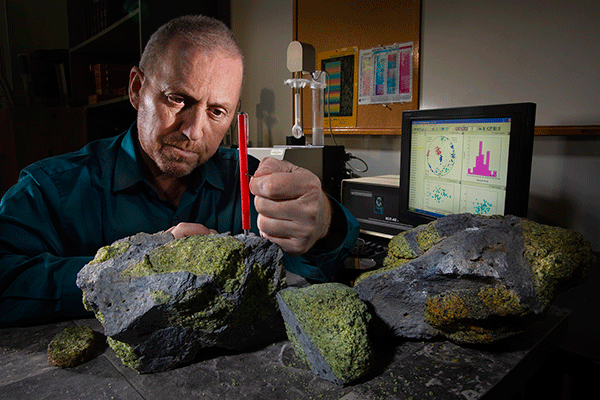Scientists have long assumed the Earth’s mantle, which makes up the bulk of the planet’s volume, wasn’t magnetic.
A University of Louisiana at Lafayette geoscientist and an international team of scholars have concluded that previous researchers were wrong.
Findings by UL Lafayette’s Dr. Eric C. Ferré and his collaborators counter the decades-long belief that the Earth’s magnetism derived only from minerals within the crust and core, two of the planet’s three layers. The third and largest layer, the mantle, which comprises about 84 percent of the Earth’s volume, was thought too hot to retain its magnetism.
Not so, Ferré and his collaborators have written in the latest Nature Reviews: Earth & Environment, an online peer-reviewed journal.
Parts of the upper mantle, located between 30 and 670 kilometers (18 and 416 miles) below the Earth’s surface, contain magnetite and a previously unknown type of iron oxide, both of which retain magnetic properties. That’s despite temperatures up to 700 degrees Celsius (1,292 degrees Fahrenheit).
That means minerals within the upper part of the mantle are playing a previously unknown role in producing the Earth’s magnetic field, without which “we would be toast,” said Ferré, director of the School of Geosciences in the Ray P. Authement College of Sciences.
“The magnetic field is precious to us. Without the magnetic field generated inside the Earth, most living species would be 'fried' by cosmic radiations. The main reason why there is life on Earth is because we are sheltered by this magnetic field.”
The mantle has an additional importance, Ferré explained. It’s where earthquakes are born.
“Up until recently, we did not really have much knowledge about the magnetic aspect of this earthquake machine. We saw it through the prism of seismic data and gravity to some extent. But now we have a new tool that allows us to see things with a completely different viewpoint.”
Ferré said the behavior of rocks inside the Earth’s mantle determines where, when and whether an earthquake will occur. Now, scientists must consider what role magnetism plays in those dynamics. Doing so may help pinpoint where future tremors will occur and could add layers of understanding to past seismic events as well, he added.
In addition to Ferré, the study’s authors are Ilya Kupenko and Carmen Sanchez-Valle, University of Münster, Germany; Fátima Martín-Hernández, Complutense University of Madrid, Spain; and Dhananjay Ravat, University of Kentucky, Lexington.
The interdisciplinary, global team used data from satellites that track changes inside the Earth’s interior to reach its conclusions. In addition, researchers replicated conditions deep inside the Earth in a laboratory using a machine Ferré compared to a pressure cooker.
“They take a very tiny piece of rock and they put it inside the vessel that essentially reproduces the high-pressure conditions that exist inside the Earth. And when they did that, they were able to see that in a simulation of the Earth’s interior conditions, there were magnetic minerals that we didn't know about before.”
These research methods are necessary, he explained, to understand what’s happening in areas within the Earth’s interior that are impossible to reach.
“When you go to the doctor, the doctor examines you and, at times, they prescribe different types of exams and scans. You can take blood samples and urine samples. You can take an X-ray of your chest. You can take an MRI. All of these different medical techniques inform you about what’s going on inside of the body of the patient.”
Ferré continued: “Our planet essentially works the same way, but if you want to know what is inside the planet, you cannot really go inside. You can go inside a deep mine, maybe three kilometers below the surface, but you need to have techniques and methods that are going to allow you to probe inside the Earth.
“The deeper you go, the better you are going to understand what is going on at the surface.”
Photo caption: Dr. Eric C. Ferré is director of UL Lafayette’s School of Geosciences in the Ray P. Authement College of Sciences. (Photo credit: Doug Dugas / University of Louisiana at Lafayette)
